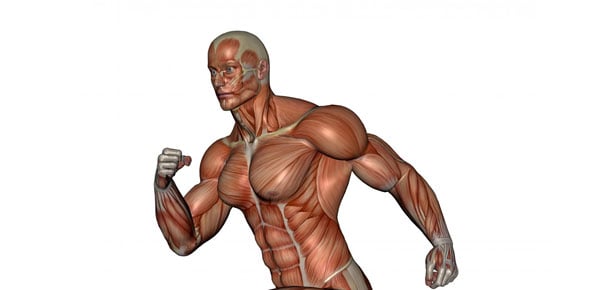Skeletal & Muscular Systems

Take this quiz after you have finished learning about the skeletal & muscular systems.
- 1.
Strips of tough connective tissue that hold bones together are known as
- A.
Tendons
- B.
Smooth muscles
- C.
Striated muscles
- D.
Ligaments
Correct Answer
D. LigamentsExplanation
Ligaments are strips of tough connective tissue that hold bones together. They are responsible for stabilizing joints and preventing excessive movement. Unlike tendons, which connect muscles to bones, ligaments connect bones to other bones. Smooth muscles and striated muscles are types of muscle tissue and are not involved in holding bones together.Rate this question:
-
- 2.
Joints that allow circular movement are referred to as
- A.
Gliding joints
- B.
Ball-and-socket joints
- C.
Hinge joints
- D.
Pivot joints
Correct Answer
B. Ball-and-socket jointsExplanation
Ball-and-socket joints allow circular movement because they consist of a rounded bone end that fits into a cup-like socket. This structure allows for a wide range of motion in multiple directions, including rotation and circumduction. These joints are found in the shoulders and hips, and they provide stability and mobility to these areas of the body.Rate this question:
-
- 3.
Smooth muscle is found in the
- A.
Walls of blood vessels
- B.
Heart
- C.
Skeletal muscles
- D.
Joints
Correct Answer
A. Walls of blood vesselsExplanation
Smooth muscle is found in the walls of blood vessels. Smooth muscle is a type of muscle tissue that is involuntary and non-striated. It is responsible for the contraction and relaxation of blood vessels, which helps regulate blood pressure and blood flow throughout the body. Smooth muscle in the walls of blood vessels allows them to constrict or dilate in response to various stimuli, such as changes in blood pressure or the need for increased blood flow to specific areas of the body.Rate this question:
-
- 4.
All of the following are important roles of the skeletal system EXCEPT
- A.
Protection of internal organs
- B.
Movement of the body
- C.
Production of red blood cells
- D.
Regulation of body temperature
Correct Answer
D. Regulation of body temperatureExplanation
The skeletal system is responsible for providing support and structure to the body, protecting internal organs, and facilitating movement through the attachment of muscles. Additionally, the skeletal system plays a role in the production of red blood cells through the bone marrow. However, the regulation of body temperature is primarily controlled by the nervous system and the endocrine system, not the skeletal system.Rate this question:
-
- 5.
Skeletal muscles are joined to bones by
- A.
Ligaments
- B.
Tendons
- C.
Cartilage
- D.
Joints
Correct Answer
B. TendonsExplanation
Skeletal muscles are joined to bones by tendons. Tendons are strong, fibrous connective tissues that attach muscles to bones. They play a crucial role in transmitting the force generated by the muscles to the bones, allowing for movement and locomotion. Ligaments, on the other hand, connect bones to other bones and provide stability to joints. Cartilage is a flexible connective tissue that cushions joints and allows for smooth movement. While joints are the points of connection between bones, tendons specifically connect muscles to bones.Rate this question:
-
- 6.
The skeletal system controls body movement, helps circulate blood, and helps move food through the digestive system.
- A.
True
- B.
False
Correct Answer
B. FalseExplanation
The statement is false because the skeletal system is primarily responsible for providing support and protection to the body, producing blood cells, and storing minerals. Body movement is controlled by the muscular system, blood circulation is facilitated by the cardiovascular system, and digestion is aided by the digestive system.Rate this question:
-
- 7.
Bones are a solid network of living cells and protein fibers taht are surrounded by deposits of calcium salts
- A.
True
- B.
False
Correct Answer
A. TrueExplanation
Bones are composed of living cells and protein fibers that are encased in deposits of calcium salts. This solid network provides strength and support to the skeletal system. Therefore, the statement "Bones are a solid network of living cells and protein fibers that are surrounded by deposits of calcium salts" is true.Rate this question:
-
- 8.
A muscle contracts when the thin filaments of _________ slide over the thick filiments of __________.
Correct Answer
actin
myosinExplanation
A muscle contracts when the thin filaments of actin slide over the thick filaments of myosin. This sliding movement is facilitated by the interaction between actin and myosin, which causes the muscle fibers to shorten and generate force. Actin and myosin are two key proteins involved in muscle contraction, with actin forming the thin filaments and myosin forming the thick filaments.Rate this question:
Quiz Review Timeline +
Our quizzes are rigorously reviewed, monitored and continuously updated by our expert board to maintain accuracy, relevance, and timeliness.
-
Current Version
-
Mar 20, 2023Quiz Edited by
ProProfs Editorial Team -
May 30, 2011Quiz Created by
Amymaschool
 Back to top
Back to top


